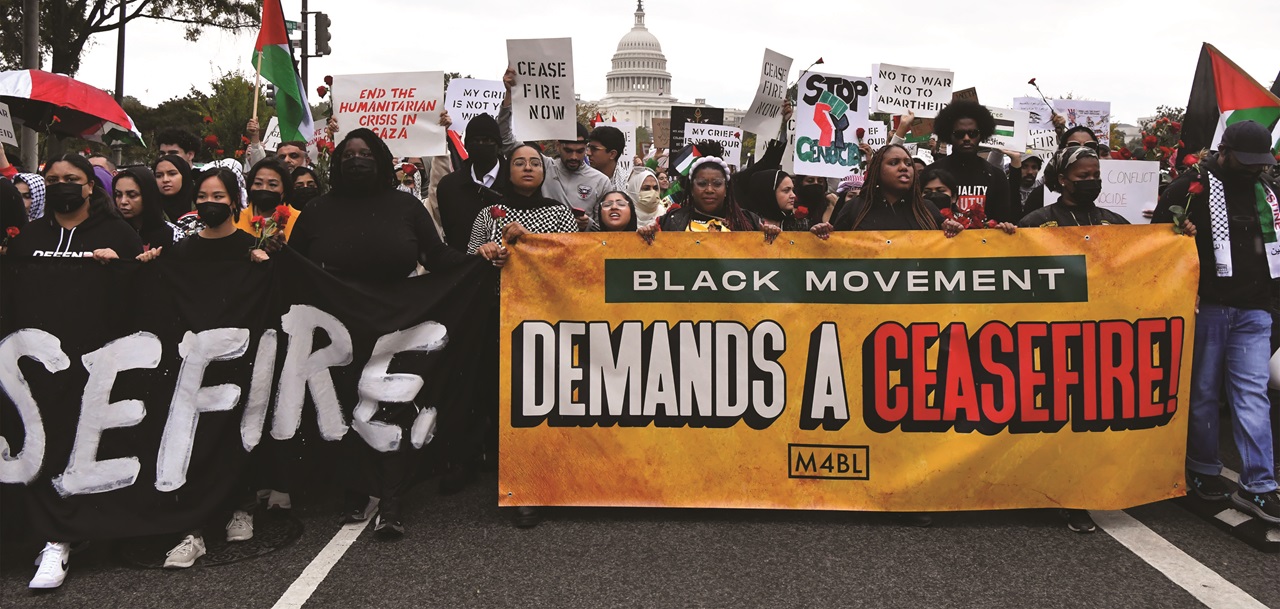
A pro-Palestinian peace movement has grown in a matter of months from scattered and spontaneous demonstrations into a major factor on the U.S. political scene.
Anyone who hoped only a few months ago that it would fizzle out and go away as we got closer to the election has had those hopes dashed. What started out as a few rallies and small marches last October when Israel began its war on Gaza has turned into a solid coalition involving a broad array of groups, including unions and their allies, civil rights organizations, religious leaders, students, and other youth, the Arab American communities in key battleground states, elected officials on the local level, members of the U.S. House and Senate, and many others.
Even what the New York Times described last weekend as a “broad attack by Iran on Israel” failed to elicit a change of position by any of the major components of the coalition for peace that has emerged both inside and outside the Democratic Party. Demands for a ceasefire and even a total end to the U.S. funding of military aid to Israel have continued.
Iran’s response to Israel was, all things considered, a relatively mild reaction to a serious provocation by the U.S. backed Israeli warplanes, an airstrike against an Iranian embassy in Damascus, Syria, on April 1, which killed 16 people, including a senior commander of the Islamic Revolutionary Guard Corps, a brigadier general and other officers, plus two civilians. It is an international crime to attack another nation’s diplomatic facility, especially with fatal intent and outcome.
The attack by Iran, which killed no one, seemed almost like a choreographed event, with Iran declaring that it was planning no further retaliation even before its slow-moving drones reached an Israeli military facility. Surely, Iran knew the Iron Dome would successfully rout its drones. The incident allowed the U.S. to declare again its “ironclad” support for Israel and, at the same time, play the role of”peacemaker” by declaring it would not support any Israeli retaliation.
The Iran attack also allowed Israel to temporarily turn attention away from its continued slaughter of the people of Gaza—where nearly 34,000 Palestinians have been killed—and play the role of victim. This even though no one was killed because Israel, with the use of the U.S.-supplied “Iron Dome” and with the help of other states, intercepted what they claimed were 99% of the Iranian missiles. Iran was allowed to save face by claiming it had “retaliated” for the bombing of its embassy, but even now Israel threatens it will again strike Iran.
In a way, the attacks showed the sophistication of the peace movement in the U.S. Most activists have made clear that by protesting Biden’s “ironclad” support of Israel they are in no way supporting his Republican opponent, Donald Trump. In fact, they have said they fear Biden must change his position if he is going to win the election. They note the closeness of the race in key battleground states, where opposition to the genocide in Gaza is particularly strong because of the presence of large numbers of Arab Americans, youth, and non-white voters who are strongly opposed to the war.
Likewise, in the case of Iran, they have not fallen into the trap of launching a defense of the policies of that country, whose leaders could care less about the fate of the Palestinians and are waging a right-wing, religious fundamentalist attack on their own people.
The coalition for a ceasefire and for an end to all military aid to Israel continues to broaden, consisting of long-time peace activists, newly-politicized youth, and major individuals and sections of the Democratic Party.
Sen. Bernie Sanders, Ind., Vt., has introduced a resolution to cut off all military funding of Israel. Reps. Cori Bush, Ilhan Omar, Rashida Tlaib, and many others are backing a ceasefire and an end to U.S. weapons shipments to Israel. Almost incredibly, in a period of less than six months, organizations focused on the fight against climate change nationwide, tenants’ rights in New York, and immigration rights in Chicago have been showing up at the demonstrations for a ceasefire.
Both rank-and-file labor activists and their unions are demanding a ceasefire. African-American religious leaders have gone to the White House itself to protest the Biden policies. Millions of messages are pouring into Congress as a result of efforts by youth using the internet to mobilize for a ceasefire and a cutoff of military support for Israel.
In Chicago, talks by a variety of the groups involved in the coalition are already discussing what their approach will be to the Democratic National Convention, which will be held there in the summer.
Maurice Mitchell, the national director of the Working Families Party, addressed the hopes some had that the movement for a ceasefire was only a temporary thing that would fizzle out. “Maybe there was an idea that, over time, the movement would lose steam or it was just like a campus thing, or that it was like a far-left sort of protest movement. The opposite is happening as the humanitarian toll becomes clear.”
The entry of the Working Families Party into the ceasefire campaign is itself an example of the expansion of the peace movement to include groups which have previously focused on domestic economic and political issues. The connection between misguided foreign policy and the inability to solve domestic problems is made clear by many of the ceasefire protests.
Another sign of the sophistication of the coalition is the ability to hold together many groups that employ a variety of different tactics. Union leaders and religious leaders issue statements, take out full-page ads in newspapers, and speak to gatherings of their members. Others have conducted civil disobedience, tying up traffic, for example. Civic groups go to meetings of town and city councils and raise signs and their voices when key politicians get up to speak. In Washington, D.C., for example, protesters show up at those types of meetings but also at informal sessions lawmakers have with their constituents at local coffee shops.
What began as a few protests by groups like Jewish Voice for Peace and some actions at college campuses has become a movement that shows up anywhere and everywhere across the country.
One result is that the Biden administration is under pressure from important parts of the Democratic Party itself. In a Pew Research Center poll released last month, a slim majority of Democrats said the way Israel was conducting the war was unacceptable. After seven international aid workers were killed in targeted Israeli airstrikes last month, Biden said he would consider conditioning further weapons shipments on how Israel addresses civilian casualties. So far, however, there has been no change.
The movement for a ceasefire is growing much more rapidly than expected. On Oct. 5, Students for Justice in Palestine at Columbia University posted an Instagram about a coming demonstration and it got 369 likes. Four days later, another post by them drew 33,000 likes.
A clear sign that the movement was really taking off came on Nov. 8, when a coalition of Black clergy ran a full-page ad in the New York Times calling for a ceasefire. It was signed by almost 1,000 faith leaders.
The labor movement in the U.S. is a key constituency that the Democratic Party depends on for votes, financial contributions, at phone banks, and for door-to-door voter contact. Soon after Oct. 7, though, younger union members and many Arab American labor activists in Dearborn, Mich., began to pressure their unions to take a stand for peace and to demand action from the president.
Brandon Mancilla, a regional director with the United Automobile Workers and supporter of the peace movement, said that by early November large numbers of UAW members were attending demonstrations wearing their UAW hats and jackets. Those workers openly expressed their hopes to see their union take a stand. In December, the UAW leaders listened, making the UAW the nation’s largest union to back an “immediate ceasefire.”
While this was happening, the Biden administration was faced with another major rebuke of its policies. In February, more than 100,000 voters in Michigan cast “uncommitted” votes in the primary election. It was only the first of many such ballot protests in the primary elections that followed.
Significant to the peace movement also is the fact that Jewish groups like Jewish Voice for Peace, IfNotNow, and others have played a central role in organizing many protests. Those groups continue to report large surges in membership as the protests continue. Members say there is no contradiction between grieving for those killed in the Oct. 7 raids by Hamas into Israel and fighting to stop the killing of Palestinians in Gaza. “No one can justify what Israel has done to Palestinian civilians,” said Martan-Arad Neeman, a spokesman for IfNotNow, in a statement.
Palestinian Americans have, of course, contributed much to the building of the movement. Ahmad Qurt, is an active supporter of the ceasefire movement in Chicago Ridge, Ill., a heavily Palestinian American community west of Chicago.
“It hurts so much to see our families and people killed in Gaza,” he said. “The pain is unbearable. My wife and I went to O’Hare Airport years ago to protest Trump’s Muslim ban. We know how bad he is, but how can we support Biden, who presides over the death of our people?”
Qurt said he fears that if the views of his neighbors in Chicago Ridge are any indication, Biden could lose in places like Michigan this year. “This is why we demand he change his policies,” he said.
We hope you appreciated this article. At People’s World, we believe news and information should be free and accessible to all, but we need your help. Our journalism is free of corporate influence and paywalls because we are totally reader-supported. Only you, our readers and supporters, make this possible. If you enjoy reading People’s World and the stories we bring you, please support our work by donating or becoming a monthly sustainer today. Thank you!










